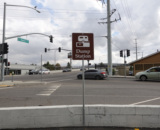In today’s global economy, the search for new ideas doesn’t stop at the water’s edge. Companies in the U.S. looking for their next great idea or seeking new ways to cut costs can find inspiration in the experience of businesses overseas.
Armed with this outlook, I recently participated in an intensive educational study tour to Europe. The agenda was aggressive (in seven days, I examined more than 40 facilities in six different countries). The goals were also clear: Look for clues to anticipate the future course of our industry and translate relevant information into useful tools and solutions for NATSO’s membership.
With the help of dozens of incredible people, I came back with a wealth of information. I traveled with Jeff Murphy, principal and managing partner of The Murphy Group, and with his colleague, Spiro Serpanos, who heads the consulting firm’s European Marketing, Retailing and Organizational Development arm. Over the course of our trip, I met dozens of truckstop operators and their suppliers who helped me navigate a truckstop industry that is both surprisingly similar and vastly different than its U.S. counterpart.
Across Europe, just like in the United States, truckstops play a vital role in supporting the trucking industry and make great contributions to their local economies. European governments and society as a whole recognize this role that truckstops play. They place a high value on utilizing truckstops to help secure freight that moves between these close-knit countries and recognize that their markets are inextricably entwined.
Cross-Border Competition
Unlike the United States, where most truckstops view their biggest competitor as the nearest truckstop, European truckstop owners operate in a global marketplace. Truckstops competing along highways that cross international borders face stiff challenges that result from international law and market forces. Many truckstops possess significant pricing advantages across country borders similar to U.S. businesses’ advantages across state borders.
In Luxembourg, a city bordering Belgium, Germany and France, trucks lined up three and four deep along 12 truck islands to take advantage of a significant tax benefit on retail products, including fuel, before crossing the border.
What’s more, fuel no longer represents the major profit center for European truckstops. Fuel prices averaging $8 to $10 a gallon forced truckstop operators to diversify their revenue streams years ago as Europeans began driving fewer and smaller, more fuel-efficient cars. Changes to motor carrier fuel buying and selling habits forced truckstops to cater to an all-inclusive motoring public, including cars, recreational vehicles and bus traffic.
Fuel No Longer a Profit Center
At the Ashford Truck Stop, just outside London, General Manager Richard Welch said fuel represents his least-profitable commodity despite its $8 to $10 per gallon price tag. A large truckstop facility employing 43 people and open 24 hours, Ashford sells fuel to just 10 percent of its customers because fuel prices are 20 percent cheaper 30miles away in France.
In reality, relatively few truckstops across Europe actually serve as fleet fueling stations. Instead, they operate as pumping facilities. Motor carriers deliver and store fuel for their company drivers to access. Truckstops instead earn what is called a pumping fee, eliminating the monetary exchange for fuel between the driver and the truckstop. Unlike the United States, where 80 percent of fleets fill up at over-the-road fueling stations and 20 percent fuel at a terminal, the majority of European trucking fleets require drivers to fill their tanks at the company terminal. This forces truckstop operators to seek revenue streams far outside the traditional realm of fuel sales.
Welch said the United Kingdom has not made money on fuel in many years and no longer invests in fuel equipment. In the 1990s, major oil companies operated many sites with a large number of employees in the U.K. That is not true today, however, he said. Changing technology coupled with bulk fuel purchasing to drive down prices— also known as a hypermarket—spurred significant growth in a variety of ways, including the addition of a number of unmanned fueling stations across Europe. These facilities provide gas, food and rest areas without the overhead of employee wages.
All told, Ashford earns profits from seven sources, including a buffet restaurant, gambling, sleeping areas, a truck wash and paid parking.
Paid Parking Standard
For Ashford Truck Stop, paid parking comprises a significant portion of annual revenues. Ashford caters largely to international truck drivers complying with rest rules under hours-of-service regulations. European hours-of-service rules result in shorter lengths of haul that in turn generate more driver down time.
Welch aims to serve 120,000 vehicles each year, which translates to 300 trucks per day. Welch admits he might be aiming too high in 2009 given the current economic climate, but he said parking represents his best chance to get drivers out of their trucks and into his facility to spend money. Parking and resulting inside sales generate a large percentage of Welch’s overall annual profits. What’s more, drivers who pay to park for the full 24-hour period receive a voucher to spend in the Ashford facility.
In Europe, paid, secure parking is in such high demand that drivers must reserve parking at Welch’s facility.
Highly Secure Parking in High Demand
At the border crossing into Calais, France, where some 5million trucks enter the port city each year, All 4 Trucks offers more than 310 paid, highly secure parking spaces as a means of helping the country reduce cargo theft and illegal immigration.
Similar to the Ashford facility, All 4 Trucks, which expects to build more than 20 locations across Europe, arranges fuel placement with fleets for a pumping fee and generates revenue by selling its security and other amenities. European truckstop operators believe that providing security helps clean up their property, and carriers and owner operators will pay to ensure their cargo is safe as long as it is reasonably priced.
Diversifying Revenue Streams Essential
In Europe, diversifying revenue streams calls for radical design. For some, this means focusing on cafeteria-style restaurants, supermarkets and fresh food bins. For others, it entails operating a truckstop around a specific community or local attraction in efforts to promote a community environment.
Italian-based AGIP offers an upscale restaurant called Marche Restaurant designed to look like an open marketplace. The Wildlife Reserve stop near Paris, France, is building an environmentally friendly facility based around a nearby attraction. And many truckstops in each of the European countries feature fresh food stations and cafeteria- style service.
European truckstops added diesel exhaust fluid to their product line several years ago for trucks operated by engines designed to meet stricter emissions standards. Interestingly, more than three years after DEF sales began, truckstops across Europe frequently offer the product both on the island and in containers.
Many of you who travel abroad may already have encountered the pay toilets, but this was also a new experience for me. Most European travel centers offer pay toilets with turnstiles and an attendant at the entrance or just inside the restroom to keep the area clean. Some of the service stations offer a coupon equal to the value paid that you can redeem inside the store.
There are certainly significant differences between the truckstops of Europe and the industry here at home, but some characteristics appear to be universal. The Europeans’ search for new ideas and approaches echoes the spirit of entrepreneurship that built our U.S. truckstop and travel plaza industry. And their willingness to share ideas with me called to mind the peer-to-peer learning and mentoring that we see among our NATSO members.
|
This article originally ran in Stop Watch magazine. Stop Watch provides in-depth content to assist NATSO members in improving their travel plaza business operations and provides context on trends and news affecting the industry. The magazine is mailed to NATSO members bimonthly. If you are a member and not receiving Stop Watch, submit a request to be added to the mailing list. Not a member? Join today or submit a request to receive additional information. |
Subscribe to Updates
NATSO provides a breadth of information created to strengthen travel plazas’ ability to meet the needs of the travelling public in an age of disruption. This includes knowledge filled blog posts, articles and publications. If you would like to receive a digest of blog post and articles directly in your inbox, please provide your name, email and the frequency of the updates you want to receive the email digest.

